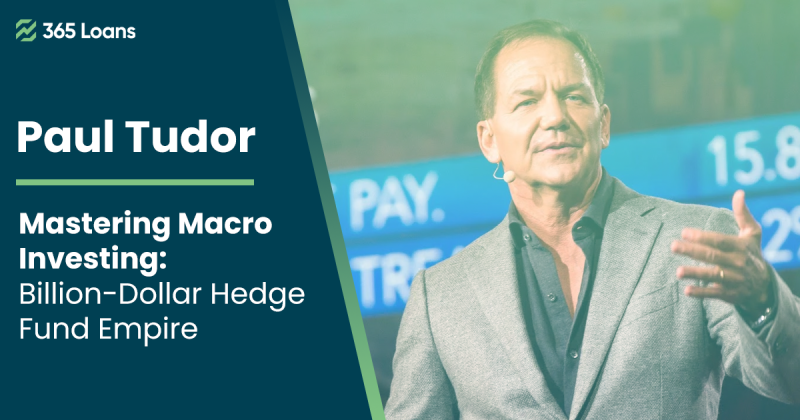Macro investing is a type of investment strategy that involves analyzing and interpreting macroeconomic and geopolitical factors to make informed decisions in the financial markets. It is a method of investing that focuses on identifying trends and patterns that can help predict market movements and identify opportunities for profit.
One of the most successful macro investors in history is Paul Tudor Jones, who built a billion-dollar hedge fund empire through his firm, Tudor Investment Corporation. Jones is known for his deep understanding of macroeconomic trends and his ability to use that understanding to make successful trades.
In this article, we will explore the story of Paul Tudor Jones, from his early life and career to the founding of his hedge fund and his philanthropic efforts. We will examine his investment philosophy, his approach to navigating market turmoil, and his impact on the world of macro investing. Finally, we will assess his legacy and consider the future of macro investing.
Early Life and Career
Paul Tudor Jones was born in Memphis, Tennessee, in 1954. He grew up in a wealthy family and attended private school in Memphis before going on to study economics at the University of Virginia. During his time at the university, Jones was a member of the Kappa Sigma fraternity and played on the school’s lacrosse team.
After graduating from college, Jones began his career in finance as a clerk at the New York Cotton Exchange. He then worked as a commodities trader for E.F. Hutton before founding his own investment firm, Tudor Investment Corporation, in 1980.
Jones’s experience trading commodities gave him a unique perspective on the financial markets. He understood the importance of supply and demand dynamics and was able to use that understanding to make successful trades in a variety of markets. Jones also learned the value of risk management early on in his career, as commodities trading can be highly volatile and unpredictable.
Jones’s success in commodities trading laid the groundwork for his future success in macro investing. He understood the importance of analyzing macroeconomic factors, such as inflation and interest rates, and how they could impact the markets. He also saw the potential for using technical analysis to identify market trends and patterns.
Jones’s early career in finance was marked by his willingness to take risks and his dedication to learning as much as possible about the markets. These traits would serve him well in the years to come as he built Tudor Investment Corporation into one of the most successful hedge funds in history.
Founding Tudor Investment Corporation
In 1980, Paul Tudor Jones founded Tudor Investment Corporation, which focused on macro investing. Jones’ investment philosophy differed from traditional value investing, which focused on finding undervalued assets and holding onto them for the long term. Instead, Jones used macroeconomic analysis to identify trends and patterns in the financial markets and make short-term trades based on those trends.
Jones believed that macroeconomic factors, such as interest rates, inflation, and currency exchange rates, could have a significant impact on the financial markets. He believed that by analyzing these factors and identifying trends and patterns, he could make successful trades in a variety of markets.
In the early years of Tudor Investment Corporation, Jones and his team achieved impressive returns, largely thanks to their use of macroeconomic analysis. They were able to identify opportunities for profit in a variety of markets, including stocks, bonds, currencies, and commodities.
One of the key factors in the firm’s early success was Jones’ willingness to take risks. He was not afraid to make bold trades or go against the prevailing market trends if he believed that the fundamentals supported his position. This approach allowed Tudor Investment Corporation to achieve returns that far exceeded those of many traditional value investors.
Navigating Market Turmoil
The 1980s and early 1990s were marked by significant market turmoil, including the Black Monday stock market crash of 1987 and the early 1990s recession. These challenges presented significant obstacles for Tudor Investment Corporation, but Jones and his team were able to navigate them successfully.
Jones’s approach to navigating market turmoil was based on a combination of macroeconomic analysis and technical analysis. During the market turmoil of the 1980s and early 1990s, Tudor Investment Corporation achieved impressive returns thanks to Jones’ approach. The firm was able to predict the 1987 stock market crash and make profitable trades based on that prediction. They were also able to identify opportunities for profit in other markets, including currencies and commodities.
Jones’ approach to navigating market turmoil was based on a deep understanding of macroeconomic factors and technical analysis. He was able to identify trends and patterns in the markets and make successful trades based on that analysis. As a result, Tudor Investment Corporation was able to achieve impressive returns despite the challenges of the time period.
Philanthropy and Giving Back
In addition to his success as a hedge fund manager, Paul Tudor Jones has also made significant contributions to philanthropy and giving back to his community. His commitment to these causes has been a core part of his identity throughout his career.
One of the most significant philanthropic efforts undertaken by Jones was the establishment of the Robin Hood Foundation in 1988. The foundation’s mission is to fight poverty in New York City by funding a variety of programs and initiatives focused on education, job training, and healthcare.
Jones has been deeply involved in the Robin Hood Foundation since its establishment, serving as the organization’s founding chairman and making significant contributions to its fundraising efforts. He has also been a vocal advocate for the foundation’s mission and has worked to raise awareness about poverty and inequality in New York City.
In addition to his involvement with the Robin Hood Foundation, Jones has also made significant contributions to a variety of other causes. He has been a vocal advocate for education reform and has made significant contributions to initiatives focused on improving access to quality education for disadvantaged communities. He has also been involved in efforts to promote environmental sustainability and support healthcare initiatives.
Jones’ philanthropic efforts have had a significant impact on a variety of causes. Through his work with the Robin Hood Foundation and other organizations, he has helped to improve the lives of countless individuals in New York City and beyond. His commitment to giving back to his community is a testament to his character and a reflection of the values that have guided his career as a hedge fund manager.
Legacy and Future Outlook
Paul Tudor Jones’ impact on the world of macro investing and the broader financial industry has been significant. His investment philosophy, which combines macroeconomic analysis with technical analysis, has been influential in shaping the way that many investors approach the markets. His success as a hedge fund manager has also made him a role model for many aspiring investors.
In terms of Tudor Investment Corporation, the firm has continued to be successful under Jones’ leadership. While the firm has experienced some ups and downs over the years, it has maintained a strong track record of returns and has continued to innovate and adapt to changes in the markets. Jones remains actively involved in the firm, serving as its Chief Investment Officer and guiding its investment strategy.

Looking to the future of macro investing, there is certainly potential for new investors to follow in Jones’ footsteps. However, it’s important to note that the investing landscape is constantly changing, and what worked in the past may not necessarily work in the future. As such, aspiring investors would do well to approach the markets with a healthy dose of skepticism and a willingness to adapt their strategies as needed.
At the same time, there is reason to believe that macro investing will continue to be an important part of the financial industry going forward.
Conclusion
Paul Tudor Jones is a self-made billionaire who has made a name for himself as one of the most successful macro investors in the world. He founded Tudor Investment Corporation in 1980 with a vision to create a hedge fund that focused on global macroeconomic trends rather than individual stocks or bonds. Jones’ investment philosophy is unique in that it combines technical analysis and fundamental analysis with a focus on macroeconomic trends.
Jones’ approach to investing has been instrumental in his success, as he has been able to navigate the markets through many turbulent periods over the years. One of the most notable examples of this was his prediction of the 1987 stock market crash, which enabled him to generate significant profits for his investors.
Looking to the future, it is clear that Jones’ influence on the world of macro investing and the broader financial industry will continue to be felt for years to come. His commitment to innovation, his ability to navigate market turbulence, and his philanthropic efforts are all part of his legacy, and they serve as an inspiration to many in the financial industry and beyond.







